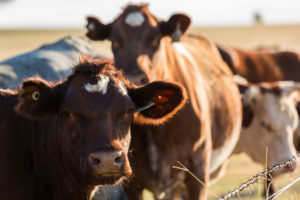
Heard of Hereford cattle in a green field.
Without proper nutrition and pasture management, the impact of this year’s drought may linger long after rains return, warns a Purdue Extension beef specialist. It’s important to know how to manage cattle during a drought season.
“The tail on this can be pretty long if we don’t manage things right in a drought year,” says Ron Lemenager. “One thing that I think is really important for producers to consider this year is body condition. If you use condition scores of these cows as a barometer of where you’re at nutritionally, we can’t do much about the heat or drought, but we can make sure we don’t have any nutritional deficiencies.”
In a drought year, forages are low in both quality and quantity, which can leave cows thin and undernourished. Less-than-optimal body conditions can have reproductive consequences, not only this year, but next year as well. Heat stress coupled with poor nutrition can create a double whammy by lowering oocyte and sperm quality, as well as embryo survival if fertilization does occur, Lemenager says.
“The environmental conditions we are experiencing have ratcheted stress forward into the heart of the breeding season for those who calve in the spring, meaning it’s very probable we’ll see more open cows than normal this fall.”
That means producers need to pregnancy-check cows to minimize the use of expensive feeds. When forages are in short supply, there is little reason to feed non-productive animals. Instead, consider marketing culled cows earlier than normal to take advantage of higher market prices.
“If we’re short on forage, we have the option of sliding by, but if cows are thin going into the fall, fewer will be bred, calves will be lighter at weaning time this year and fewer calves will be born next year,” he says. “Then, if cows are thin heading into next breeding season, fewer cows will be bred and colostrum quality will be lower, meaning a lower calf survival rate, which affects productivity in years two and three.”
To avoid the three-year “tail,” he says producers might need to pay the price now to supplement feed and make sure cows are healthy and in moderate body condition.
Lemenager and Purdue Extension forage specialist Keith Johnson list steps producers can take to manage drought and heat stress:
- *Avoid overgrazing and employ rotational grazing.
- *Creep-feed calves to create near normal weaning weights.
- *Early wean calves to take pressure off cows and pastures.
- *Identify and manage poisonous plants in pastures and hayfields.
- *Establish summer annuals to increase late-season forage production.
- *Pregnancy-check and market cull cows earlier than normal to reduce feed needs.
- *Inventory hay and other feed resources.
- *Analyze feeds for nutrient profiles to help determine supplemental feed needs.
- *Use alternative feeds to supplement and stretch forage supplies.
- *Limit hay access time to stretch forage supplies.
- *Limit-feed a high-concentrate diet to stretch forage supplies.
- *Graze crop residues and stockpiled forages to reduce harvested feed needs.
- *Use drought-stressed corn for grazing, green chop or silage.
- *Make sure cattle have access to a clean, cool water supply.
- *Moisten the soil around the ground rods of electric fences.
Source: Purdue University Animal Sciences
Tags: cattle, drought, manage cattle
